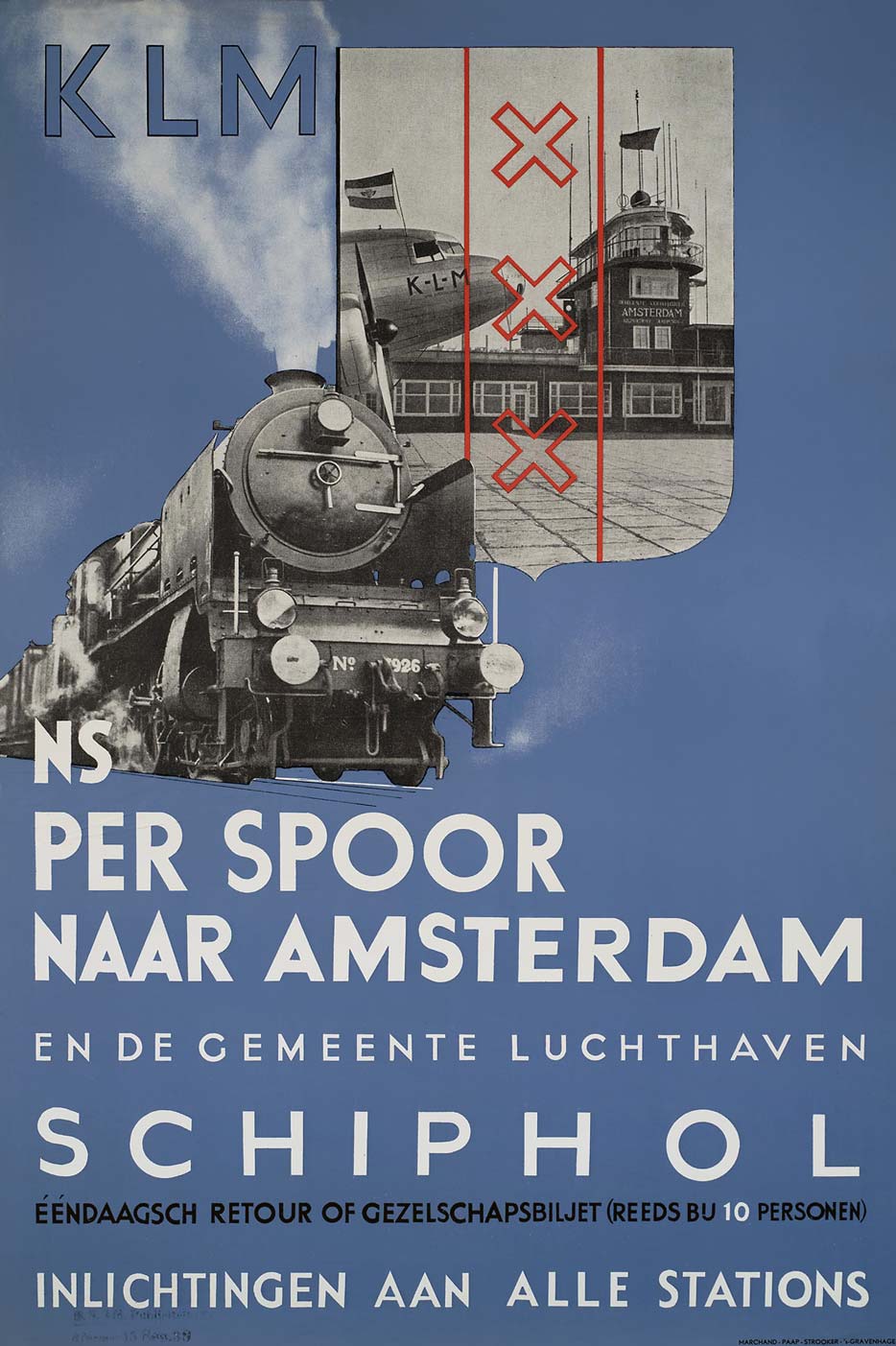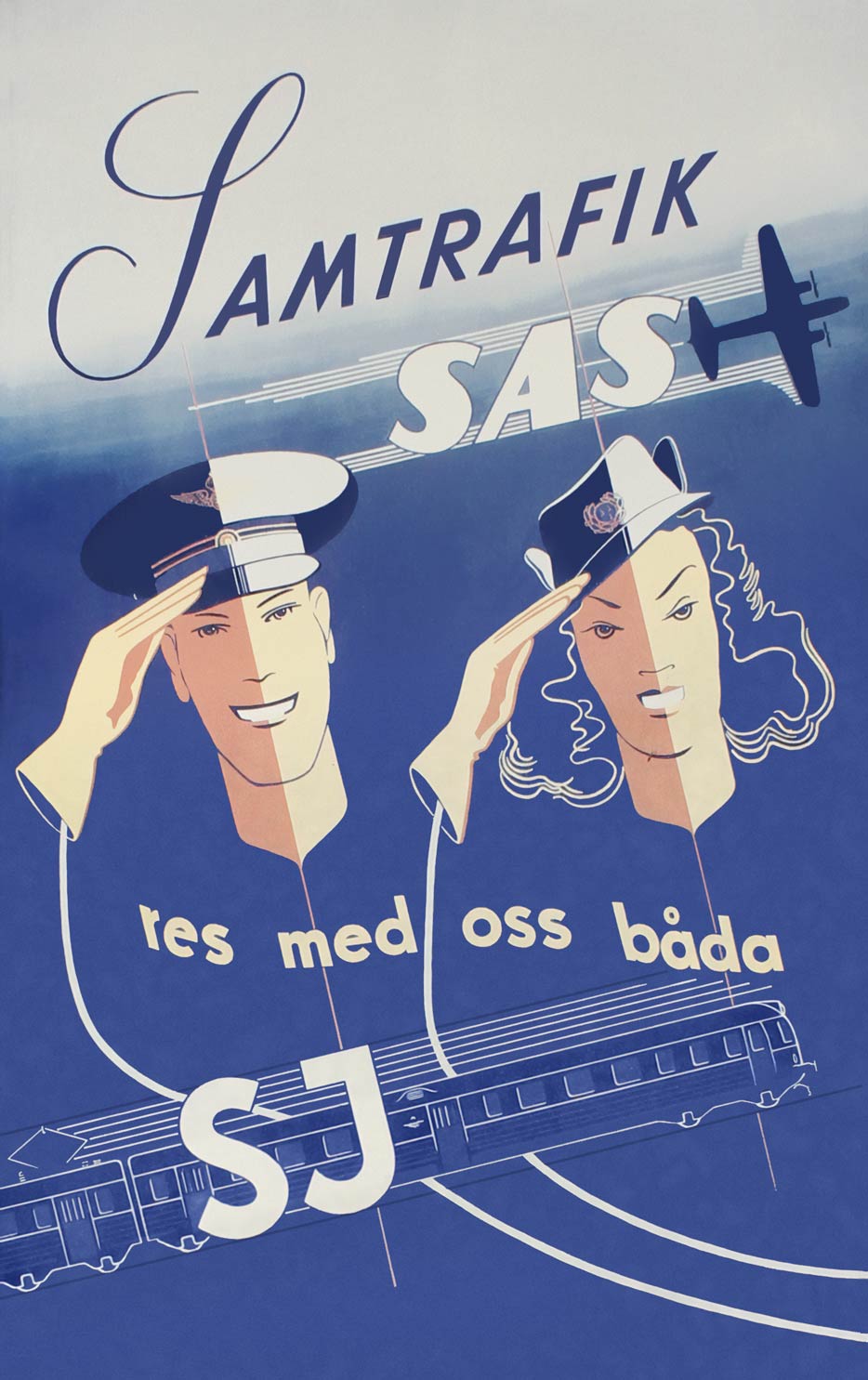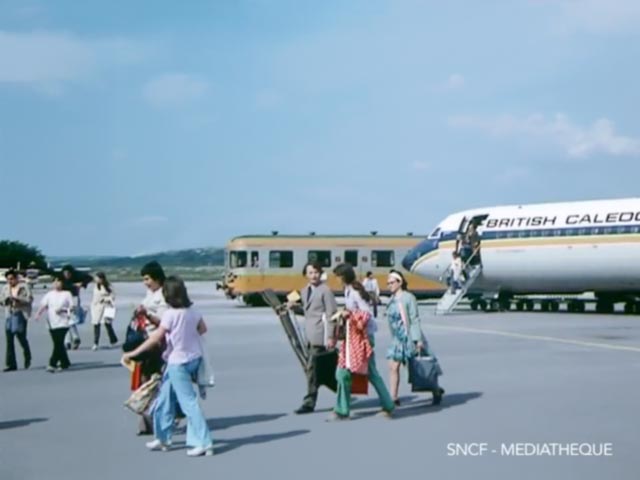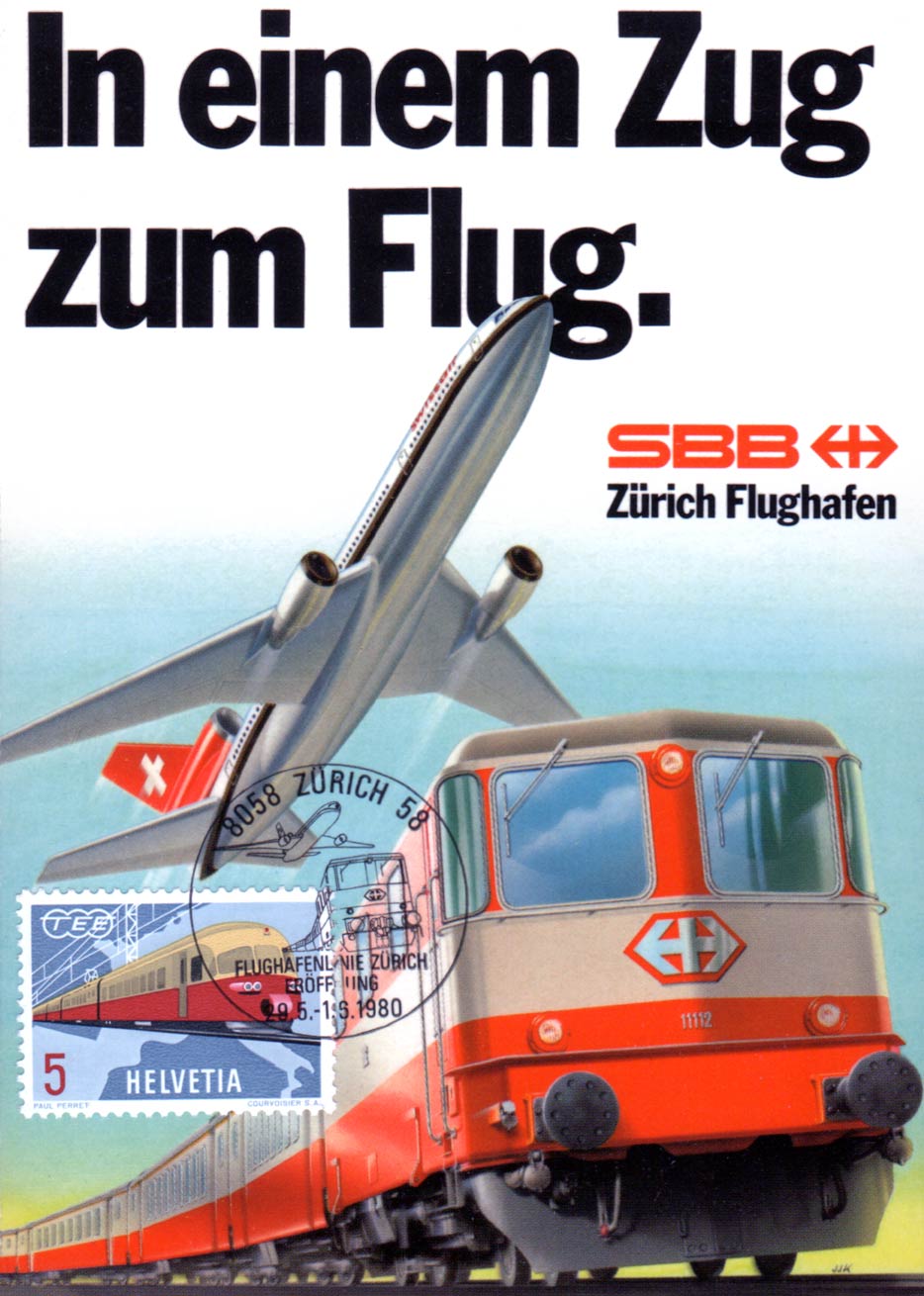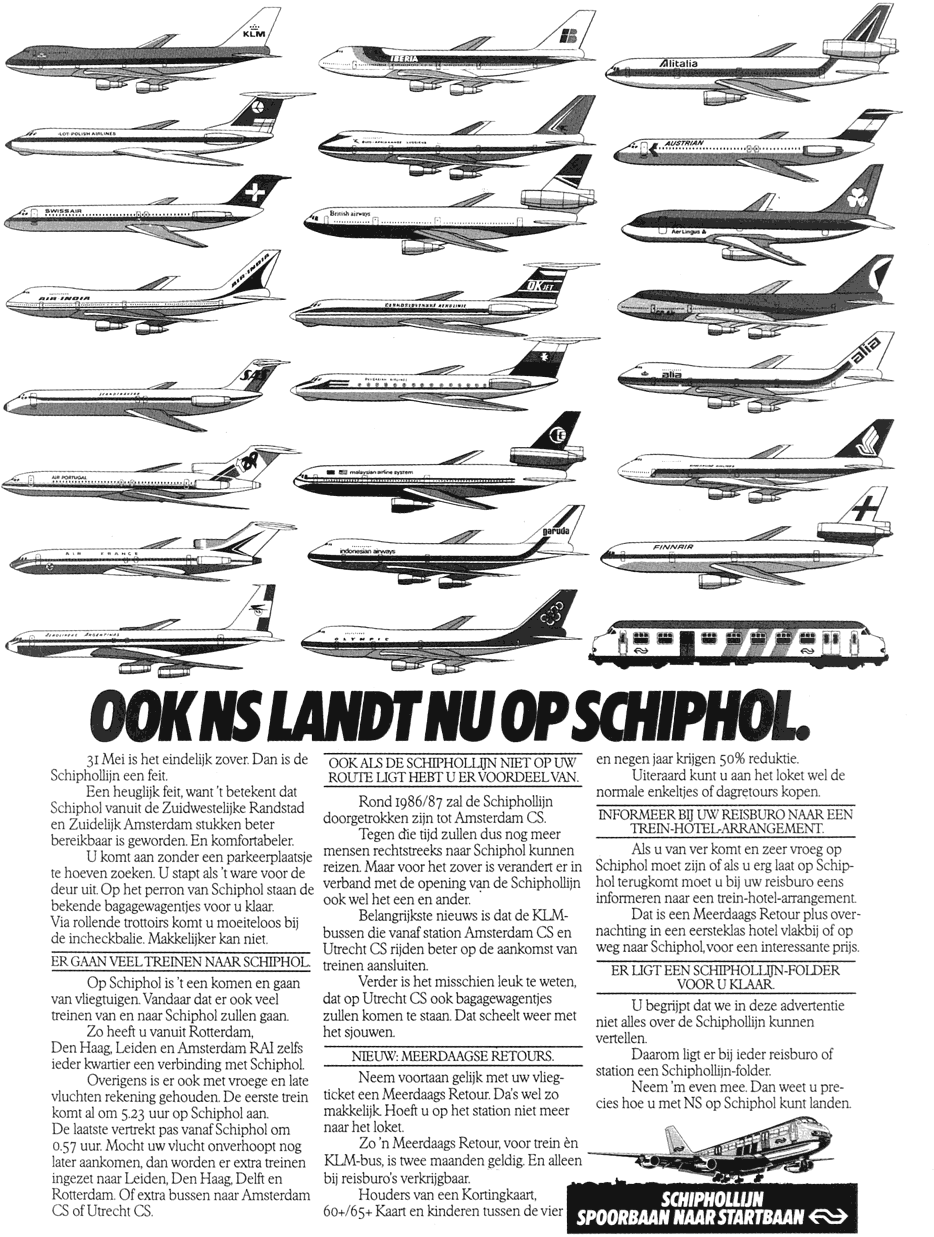Railway to runway
Train & plane publicity and posters
 Nederlandse versie
Nederlandse versie
In the course of the 20th century train and airplane became competitors, but they also supplemented each other. European railway companies and airlines jointly promoted the train as the ideal way to the airport. They issued combined tickets, while in practice a bus link between station and airport was often required.
Posters and ads featured images of rails as a runway, flying trains and rail and flight staff working together. These pictures were accompanied by catchy slogans such as Air-Fer, Train to Plane, Rail & Fly and Zug zum Flug. At the end of the 20th century the ideal of integrated transportation to a large extend became reality.
Railway Air Services
In the UK of the 1930s the railways were airline companies themselves. The four main railway companies — LMS, LNER, GWR and SR — acquired a license for domestic flights. In 1933 Great Western Railway started the first air link between Birmingham, Cardiff and Plymouth. Planes were chartered from Imperial Airways. The following year Railway Air Services (RAS) was established by the joint railway companies, a preview of their upcoming merger. The main route was London-Birmingham-Manchester-Liverpool-Belfast-Glasgow. RAS operated from London's Croydon Airport and had its own fleet of British-manufactured De Havilland Express and Dragon Rapide double-deck planes.
Flight routes across the northeastern LNER areas were never realised. Civil aviation almost came to a halt during the Second World War. In 1944 the joint railway companies submitted The Rail-Air Plan to the British government, a proposal for a vast network of European flight connections. A poster reflected their ambitions: 20,000,000 Miles a Year. In 1946, however, British European Airways (BEA) was established, a predecessor of British Airways. The role of the railways in the sky was over.
Air-Fer
In 1933 five early French airlines merged into Air France. The French railway companies were working on their own merger, which was established in 1938 as SNCF. Two years earlier, on the oldest known rail-air poster, they already communicated together as Chemins de fer français. Combined railway and airline tickets were advertised under the title AIR FER. Designer Roland Hugon (1911-?) created a photomontage of train tracks pointing to a plane taking off, with the text Vous quittez l'un vous prenez l'autre (you leave one, you board the other).
In the next decade, shortly after World War II, the AIR-FER designation was used for SNCF's goods shipping service, which offered a seamless connection to airmail. Parcels could be dropped at all stations and Air France agencies. On the poster a track leads directly into the plane like a conveyor belt with packages. Illustrator Renluc was probably inspired by the Bristol Freighter with nose doors, operated from Le Touquet airport to England from 1948 onwards, even though it had only two engines instead of the depicted four.
Per spoor naar Schiphol
The Amsterdam municipal airport of Schiphol became the national airport of the Netherlands in 1938. The KLM home base was located in the Haarlemmermeer polder outside the city, not close to any railway station. Nevertheless the Dutch Railways (NS) advertised train trips to Schiphol in the 1930s. A bus service connected to Amsterdam Central Station. The poster, featuring photos of the control tower with a DC-2 and of a 3900 locomotive, was more focused on day-trippers than air travellers, judging from the one-day return and group tickets offered. Schiphol had become an attraction.
During WW II, civil aviation was suspended and Schiphol was severely damaged. In the months after the liberation the airport gradually resumed operations, but had a provisional terminal building for years. In 1946 the Dutch Railways issued a poster for Rail-Airplane tickets, allowing passengers to travel from any station to any airport in Europe. The required bus ride still remained unmentioned. The designer put a train driver's hat and pilot hat on the large chocolate-like NS and KLM letters. German-born Arthur Goldsteen (1908-1985) also designed NS posters for the Pullman train to Paris — where he had worked for years — and the Holland-England ferry service via Hook.
Samtrafik tåg-fly
Since 1946 the national airlines of Denmark, Sweden and Norway operated jointly as Scandinavian Airline System (SAS). At first this only applied to intercontinental flights, but after a few years SAS also flew to European destinations. From 1949 onwards the Swedish State Railways (Statens Järnvägar, SJ) offered combined tickets for trains and planes in cooperation with SAS. They could be purchased at railway stations, travel agencies and SAS offices. The main airport was Stockholm-Bromma, a short bus ride from Stockholm Central Station.
Around 1950 several posters for samtrafik (interconnection) between train and plane could be found at Swedish stations. An aesthetic composition by Sarleren Garter visualised the comparable passenger comfort, while an anonymous designer depicted rail and air personnel. A SJ conductor and a SAS stewardess are saluting the passengers, calling res med oss båda (travel with both of us).
Mit Zug zum Flug
In the 1950s aviation started to become a major competitor for the railways — but only over long distances, and mainly for business travellers. In 1958 the joint European railway companies responded with the Trans Europ Express (TEE), a network of fast and luxury day trains for distances of up to 1000 kilometers. In many respects this service between dozens of European cities was modelled on air traffic, including price, service, catering and interior design.

In 1961 the German Federal Railways advertised the Trans Europ Express as a domestic supplement to Lufthansa's air connections, rather than an alternative to flying, which the TEE originally aimed for. In addition to a generic aircraft, illustrator Herbert Kapitzki accurately depicted a TEE train, an iconic VT 11.5 passing along Cologne Cathedral.
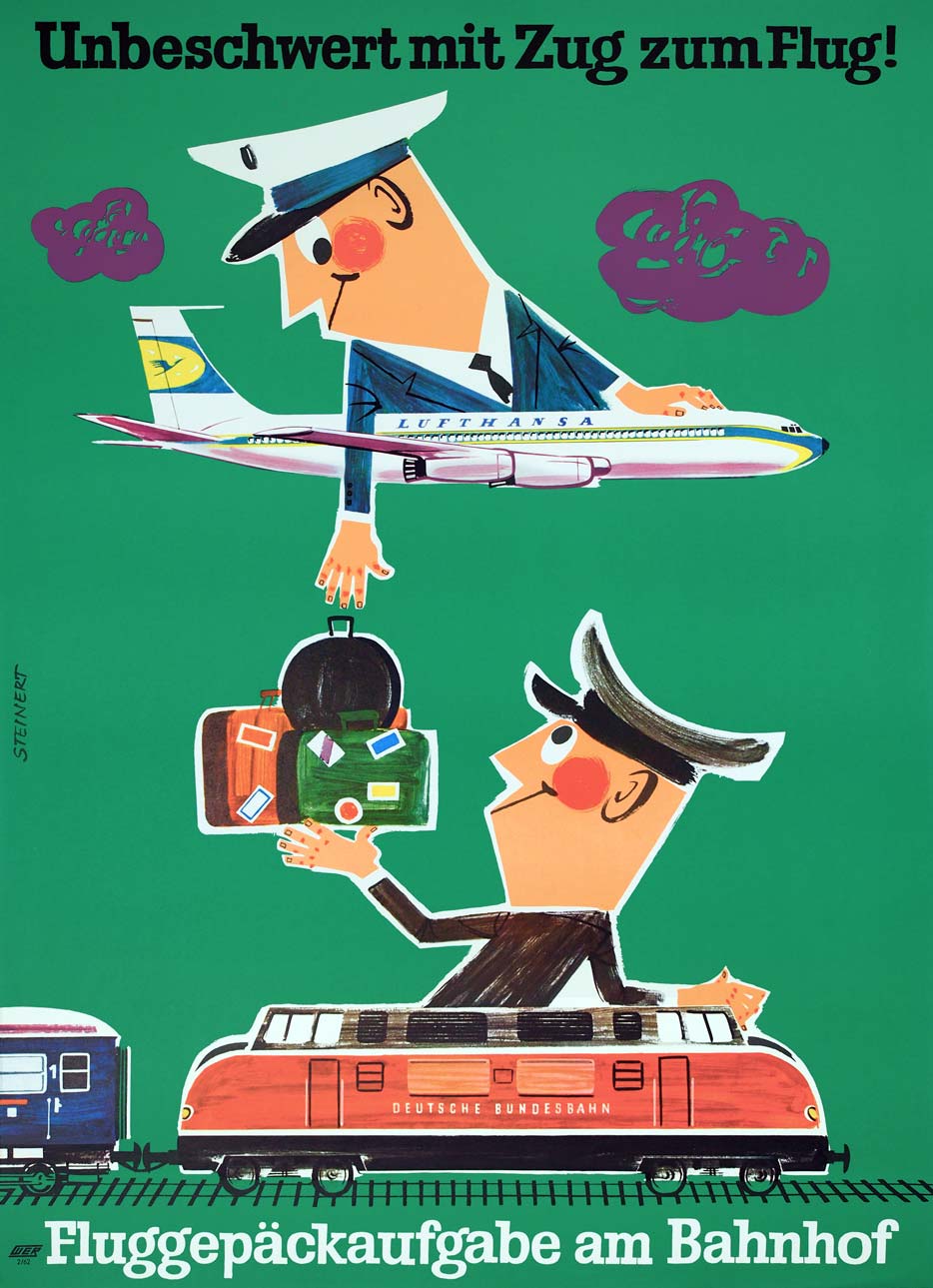
The smooth luggage service aviation clients were used to could also be offered by the railways, according to a poster titled Unbeschwert mit Zug zum Flug (carefree travel by train to plane). Travellers could drop their luggage at railway stations.
Silver Arrow

The Flèche d'argent or Silver Arrow was a combined train-flight connection between Paris and London. In 1956 the service was named after the stainless steel X 2051 trainset, with a reference to the legendary Golden Arrow boat train. The train connected Paris-Nord with the Étaples station near Le Touquet airport (Pas-de-Calais). From there the Compagnie Air Transport (CAT) flew the passengers across the English Channel to Gatwick Airport, where a train to London Victoria stood ready. The total journey took five hours. In the 1960s the flight was operated by British United Airways (BUA) with Viscount planes. Transfers became even faster with the construction of a small railway station right at the airport.
In 1971, at the request of BUA's successor British Caledonian, the track was further extended onto the runway. Nowhere else the link between train and plane was so direct. Travel time decreased to only four hours.

The Silver Arrow was a close cooperation between the SNCF and British Rail, as illustrated by Guy Georget, who designed many SNCF posters. On the English version of his poster the logos of both railway companies were on a single train!
Orly-Rail
Around 1960 Orly airport, 14 kilometers south of Paris, was expanded with the hypermodern Orly-Sud terminal. The architecture by Henri Vicariot was remarkable because of the use of steel, aluminum and glass. In addition to a terminal it was also an entertainment center with shops and cinemas. Orly-Sud attracted millions of visitors and became a symbol of French modernity. Because of growing air traffic a new terminal Orly-Ouest followed around 1970. At the same time a nearby railway was reopened with Pont de Rungis as a new station. Under the Orly-Rail name shuttle buses connected the station with the terminals.
In the winter of 1978-79 La Fête du Rail was held at Orly-Sud, a railway exhibition in collaboration with SNCF and Wagons-Lits, featuring a lot of model trains. With themed events like the rail festival, Aéroport de Paris wanted to attract visitors in addition to air travellers. In any case La Fête du Rail resulted in a beautiful poster of a steam locomotive merging with a jet plane, drawn by François Garcia.
Apart from being an air traffic hub, the airport of Paris is also an event center, visited by millions of people each year. For them we previously organised various manifestations on original themes. This year the airport hosts the 'Fête du Rail'. This is certainly an innovation, I think, and a good opportunity to confirm the mutual relationship.
Railways and aviation are the two major national transport services that participate in all forms of our economy. They both demonstrate the imagination, knowledge and effectiveness of French scientists and technicians. They also have in common that they can call forth vocations and passions that combine technical progress with the art of good living.
Railair Link
Gatwick Airport had been connected by rail to London Victoria station since 1958, but from 1970 onwards British Rail began to advertise rail-flight connections under the Railair Link name. For Heathrow Airport it was possible to travel via Reading, an attractive connection circumventing London for passengers from the south and west of the United Kingdom. Express coaches ran between Heathrow and Reading station.
At the end of the 1970s colorful posters and brochures for Railair Link were issued. They showed line drawings of airplanes, such as a Boeing 747. The illustrations, created by Ginger Tilley for the Cato Johnson advertising agency, were accompanied by slogans such as Train to plane and Take off to Heathrow by train. In 1982 Railway to Runway became the motto, with a new illustration of a railway track as a runway.
Forget about congested roads and the strain of driving for hours on the motorway, or frustrating routes through busy towns and cities. Forget time consuming stops at motels and restaurants. Forget the very high costs, let alone security, of long-stay car parking at the airport or in one of the car parks miles away. Now, there's a much better, easier way to Heathrow and Gatwick. It's Railair, the modern rail-to-air service that starts at your local rail or Underground station.
Whether you're coming from North, South, East or West, simply take one of Railair's many fast, no-fuss connections to the airport. It all adds up to a better, easier — and sometimes cheaper way to start your holiday. Children love a train ride, and so will you, once you've 'flown' Railair from your local British Rail station. It's so easy… Railway to Runway!
Gatwick Express
Catch the train and you've caught the plane was how in 1984 the new Gatwick Express was announced. It linked London Victoria directly to the airport in 30 minutes, leaving every 15 minutes. The express even ran once an hour overnight. The young and ambitious Hedger Mitchell Stark advertising agency created a television commercial on a limited budget, featuring a playful animation of the famous British Rail logo partly taking off as a plane. The poster was also based on this gimmick. A year later another poster was posing the rhetorical question What's long, air-conditioned and flies to Gatwick in 1800 seconds?
Flughafenlinie
It wasn't until around 1975 that railway lines were specially laid out to airports. An example is the Flughafenlinie to Zurich airport, home base of Swissair. The Swiss Railways decided that a local link to Zurich was not sufficient, because air passengers came from all over the country. For that reason the new railway section and underground station became part of the frequently used Intercity link between Zürich Hauptbahnhof and Winterthur. On 29 May 1980 the British Queen Elisabeth II was the first passenger.
Swiss-American illustrator Jack J. Kunz (1919-2009), known for his hyper-realistic images of ketchup bottles, depicted a Swissair plane with an SBB train, hauled by the 11112 locomotive. Of this poster, titled In einem Zug zum Flug (with a train to the flight), a postcard was issued with a special postmark of the Flughafenlinie inauguration. In 1987 Geneva airport was also connected by rail. A poster from that period labeled Weltweite Bahnverbindungen (world-wide rail connections) shows a plane with a conductor's hat and bag.
Schiphollijn

An airport railway line was also constructed in the Netherlands. The first part of the Schiphollijn and the six kilometer long Schiphol tunnel was completed in 1978, but it wasn't yet connected to the railway network. In 1981 the Schiphollijn became fully operational through its extension to Amsterdam RAI station and Leiden. On that occasion the Dutch Railways (NS) started an advertising campaign with the slogans Railway to runway and NS now also lands at Schiphol. A photorealistic illustration by A. Laurent attracted attention with a winged version of the Mat '64 trainset. A multi-day return ticket was introduced for airline passengers, while people welcoming or saying goodbye received a free return journey.
Step by step the railway links were improved. In 1986 the west branch of the Schiphollijn to Amsterdam Central was opened, an important connection. For that occasion two NS Intercity trains were given a KLM and Martinair livery, making them look like planes. In 1993 the eastern extension of the line provided connections with the rest of the country. The original round railway station was demolished in 1995 when the station was fully integrated in the Schiphol Plaza airport building. The tracks were also redoubled, anticipated in 1990 by high-profile designer Anthon Beeke with a poster of a boy with fluffy wings and train-shaped roller skates, adorned with tourist paraphernalia. The styling was done by Graham Hollick.
How to improve a plane
In ads aimed at air passengers, trains were sometimes depicted as planes. This also happened the other way around when the railways were trying to compete with aviation. In 1985 a British Rail poster set the InterCity as an example for the improvement of airplanes. It showed a cross-section of a plane with a train interior.
Advantages included 'landing' in the city center, more legroom, freedom of movement without the need to belt up, opposite seats enabling conversations, views unblocked by clouds, fresh meals with real cutlery as well as more loos, less queues.

Rail & Fly
In the 1980s the German railways promoted a special ticket offer for Zugvögel (migratory birds/train birds). The Rail & Fly campaign used an image of a flying locomotive of the 103 Class, fitted with wings using a Paintbox system (a Photoshop predecessor). Yet it were not the railways themselves that offered the best rail-air connection. In 1982 the Lufthansa airline company started its own train service between the airports of Düsseldorf and Frankfurt. The goal of the Lufthansa Airport Express was to reduce connecting domestic flights, in order to get more capacity for long-distance services.
Exactly 10 years ago the Airport Express started on the Rhine railway between the airports of Düsseldorf and Frankfurt. What started as an experiment for 12 months has now become a flagship of integrated transport: to date Lufthansa is the only airline that has its own train alongside its air fleet. The cooperation with Deutsche Bundesbahn is based on the shared conviction that both modes of transport must complement each other, on the basis of their respective strengths, for economic and environmental reasons.
Over 1.5 million passengers already traveled with the Lufthansa connection at 'altitude 0' through the picturesque Rhine Valley. Although the Airport Express is just a flight according to our schedules, it has remained something special. Guests highly appreciate the train journey, which starts with a welcome drink and plate service. Foreign guests in particular take the train in the first place because of the beautiful route along the Rhine.
The Lufthansa express used Class 403 trainsets, experimental precursors of the ICE high-speed train, nicknamed 'Donald Duck'. They were given yellow-white Lufthansa colors and airplane-like interiors. The train was only accessible with an airline ticket, and luggage was forwarded directly to connecting flights. The service even had a Lufthansa flight number. A proverbial epithet for the Lufthansa Airport Express was Flughöhe Null (altitude zero). In 1990 a second connection between Stuttgart and Frankfurt-Flughafen followed. Shortly after the the extensive celebration around the tenth anniversary of the Lufthansa Airport Express, it became outdated by the ICE high-speed network.
In 2011 Deutsche Bahn, together with the TUI fly airline company, made the image of 20th-century advertising campaigns reality: a winged train in the sky! A Boeing 737-800 was painted in such a way that the airplane strongly resembled a ICE high-speed train, and also fitted with the time-honored slogan Im Zug zum Flug.




